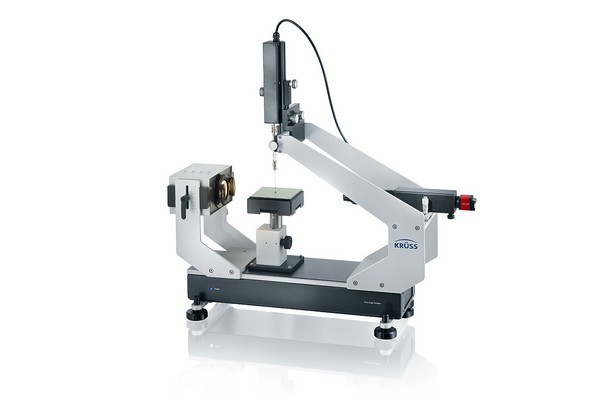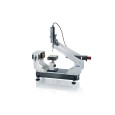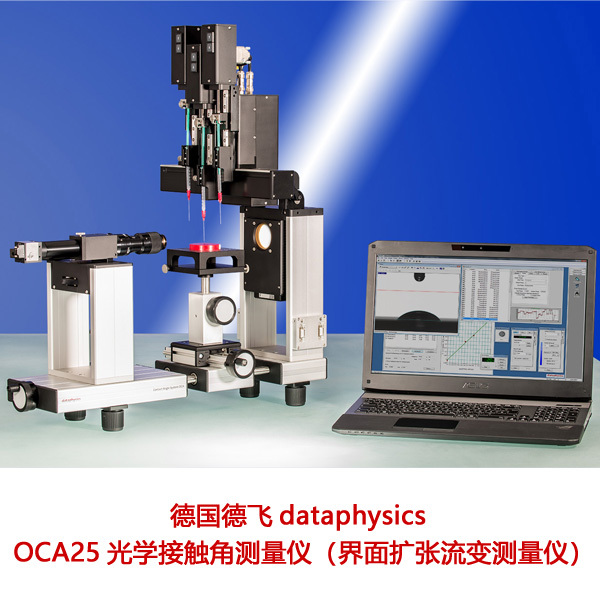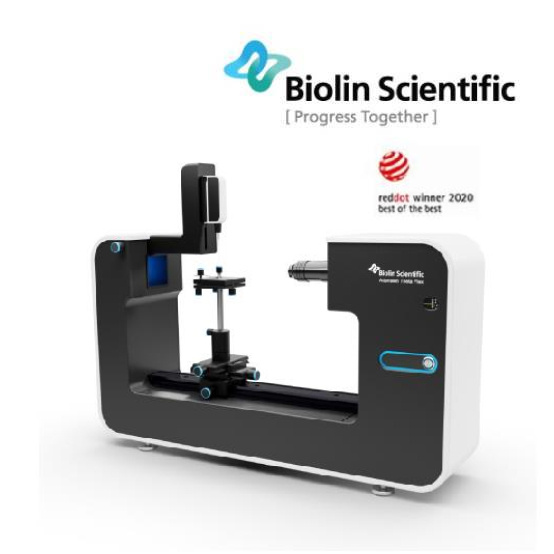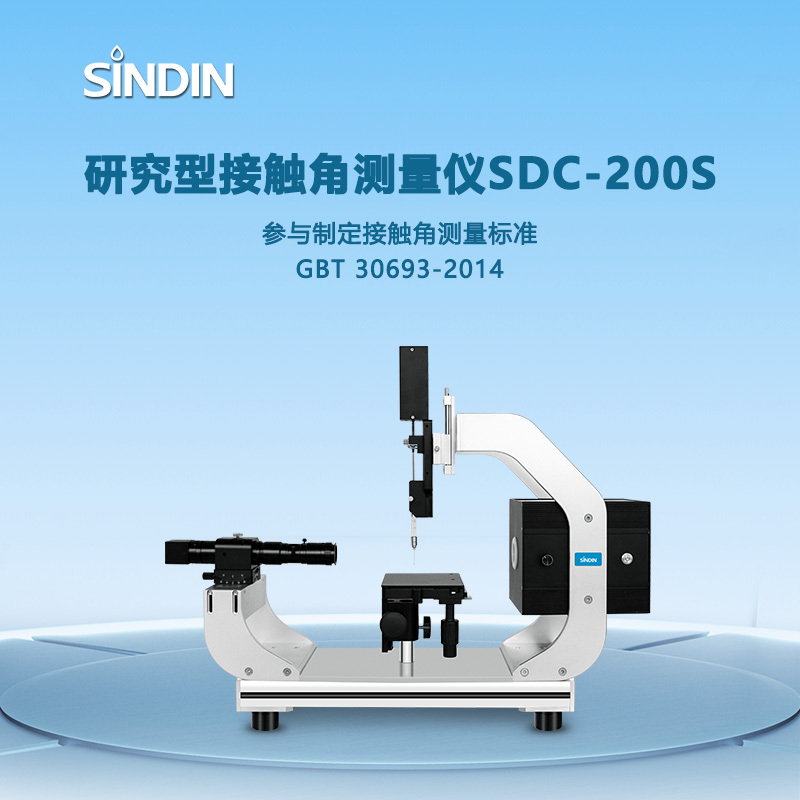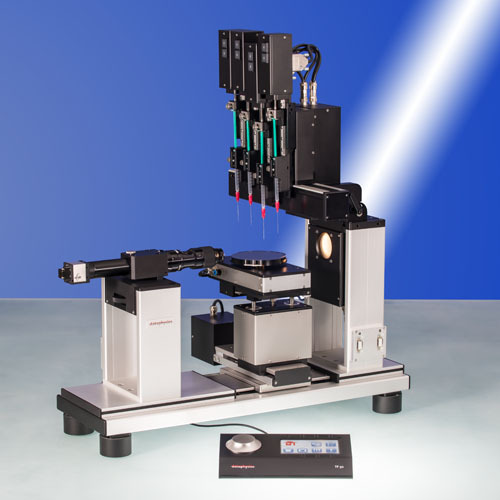方案详情
文
测量水凝胶如隐形眼镜和各种溶胶-凝胶表面性质和润湿性非常困难。对于极易润湿或不均一表面可使用环境室或补泡法测量接触角。
方案详情

KRUSS Application Report Hydrogel Wetting Application report: AR255e Industry section: Polymers, Hydrogels Author: JC Date: August 2006 Method: Drop Shape Analyzer- DSA100S Keywords: hydrogels, basic research, methods, polymers, contact angle, wettability, captive bubble, environmental chamber Methods for Wettability Determination on Hydrogels Abstract Background The measurement of surface properties and wettability of hydrogels, such as soft contact lenses and a variety of sol-gels,can be very difficult. The difficulties stem from the ability to measure wetting on a wetted surface as well as theprobability of drying, and thus the changing of surface properties, as an experiment proceeds. Methods for determiningwettability on such samples are described below, using either an environmental chamber or a captive bubblearrangement for measuring contact angles with water. A Kruss DSA100S instrument was used to determinecontact angles of water on hydrogel polymers. The sameinstrument and samples were also used for determiningcaptive bubble angles inside water. Experimental section Hydrogel production has expanded greatly over the lastseveralyears with the expanding popularity of softcontact lenses. The durability and comfort of lenses canoften be related to the wettability of the hydratedpolymers (hydrogels) contained in the lens. However, themeasurement of this wettability is not always a straightforwardproposition. Here, we will take 3 differentapproaches on hydrogel measurement. 1 -Water contact angle measured under ambientconditions This experiment is very easy to accomplish and collectdata. The lens is allowed to sit on the sample stage and adrop is placed on the sample. An 8 pl drop was formedand placed on the sample as the contact angle wasmeasured by the cone section fit (Kruss "tangent method1"). 2-Water contact angle measured under anatmosphere of saturated humidity In this experiment, a Kruss environment chamber TC3010was used. A non-woven textile was saturated with waterand placed in the chamber at room temperature. Thechamber was allowed to come to equilibrium conditionsso that a saturated (nearly 100%) relative humidityenvironment was achieved.At this point, the contact lenssample was introduced. Again, the chamber was allowedto come to an equilibrium saturation condition. At thispoint, a drop of approximately 8 pl was allowed to fallfrom a 0.5 mm OD needle tip and a movie of the eventwas subsequently recorded using Kruss DSA1.9 softwareon a CF3210 camera set to measure at 360 images persecond. The movie was subsequently analyzed using acircular fit to the drop shape. The circle fit was appliedsince this is generally the best approach for drop contactangles of very small values (below 10 degrees). 3 -Captive bubble contact angle of air measuredunder water For this experiment, a Kruss captive bubble needle andcuvette (part number SC13) was filled with water, and thesample was placed on the resting mechanisms. Toprevent collapse of the lens sample, a specific chuck wasmade to support the lens of approximately the sameradius of curvature as the interior of the lens itself. Thecurved needle was positioned by eye to be as centeredas possible on the apex of the lens curvature. At thispoint, an air bubble of approximately 10 ul was placed onthe lens apex and a contact angle was measured for thecaptive bubble with the needle still inside, by the conesection method fit ("tangent1 method"). Results Results for each experiment are contained in the tablebelow. During the experiment conducted under atmosphericconditions the lens dries out in less than 3 minutes. Thisdesiccation of the lens adds to the difficulty of theexperiment by introducing ripples and bends in thesample as demonstrated in the picture below. Along with the difficulty of not being able to find anappropriate surface of the sample to measure on, thecontact angle measured under these conditions is alsono longer that of a completely hydrated polymer system.The drop stays on the surface for a reasonable amount oftime and can be measured at the will of the user. Theprimary problem being that the sample can no longer beconsidered as its original hydrogel polymer. For the second experiment, the problem stems from theissue of measuring the contact angle of a drop of wateron a substrate that is wetted with water. As can beimagined, the contact angle is generally very low tobegin with when a drop impacts on the surface.Following this, the drop tends to spread and completelywet on the already wetted surface. Even with a360 frames per second high speed camera, the firstreadable contact angle measurement is at 9 ms after thedrop appears in the image screen and gives a contactangle of approximately 8°. In the next frame, at 11 ms,the drop has completely vanished and has wetted thelens. It is difficult or impossible to collect comparativedata between different formulations of hydrogels withsuch little data collected from the very fast wetting ofsuch polymers. In the third experiment, the contact angle of a captivebubble of air was determined against a contact lensimmersed in water. Again, to properly see the bubble three-phase pointwhere it intersects the surface of the lens, an appropriatechuck needs to be fabricated which has the sameapproximate radius of curvature as the inside surface ofthe lens. Without this chuck, the lens collapses upwardfrom the buoyancy of the bubble. As you can see from the data table, the captive bubblecontact angle is far different from that associated withthe hydrated lens under saturated humidity conditions.This value must be interpreted conversely to that of usualwettability numbers. The higher this number is thegreater is the wetting by the liquid contained in thecaptive bubble cuvette. |Contact Angle(degrees) water at atmospheric conditions 77 water at saturated humidity conditions ≤10 air contact angle in water 151 Tab. 1: Contact angle on contact lens hydrogel under eachexperimental condition Summary Measurement of wettability on solvated hydrogels canintroduce a number of difficulties. The primary obstaclefor hydrogels is the drying of the sample, which canchange the results for such polymers greatly as the stateof hydrationischanged. Anotheravenue ofexperimentation that can be usefuliis to measurestandard water contact angle on a sample that cannotdry out. This is achieved by placing the sample in acontrolledenvironment chamber with a saturatedhumidity environment. Here, the problem occurs thateven the fastest frame rates of movies of drops wettingan already wetted surface lead to a very limited amountof data. The simple solution to measuring on andcomparing hydrated samples is to use the captive bubblemethod as described above. Although set up andacquisition of captive bubble experiments and data canbe a bit tricky and time consuming, the data achieved willbe useful and well worth the time consumed. KRUSS GmbH|Borsteler Chaussee Hamburg| Germany|www.kruss.de|
确定
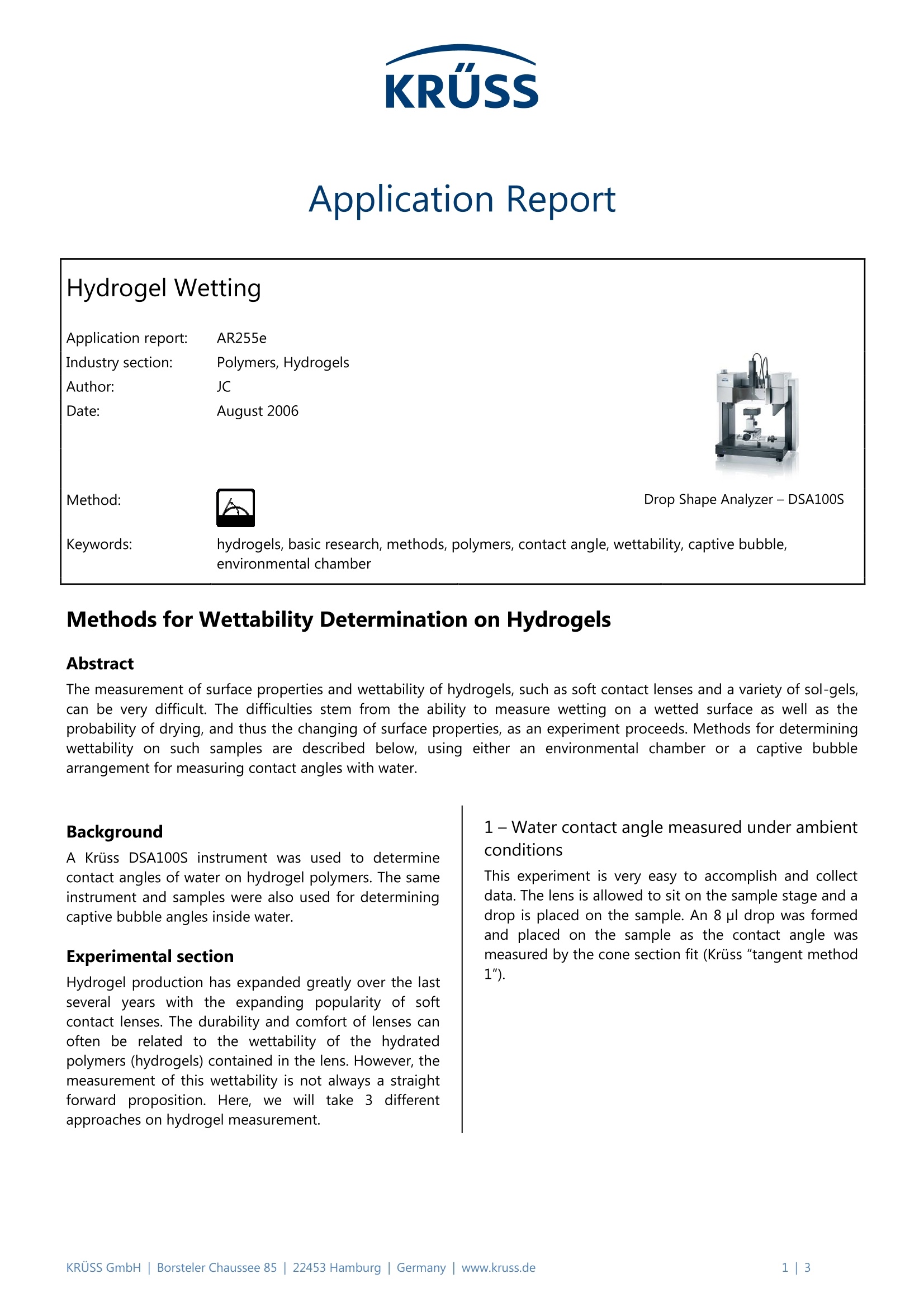


还剩1页未读,是否继续阅读?
克吕士科学仪器(上海)有限公司为您提供《滴眼液中润湿性检测方案(接触角测量仪)》,该方案主要用于化药制剂中理化性质检测,参考标准--,《滴眼液中润湿性检测方案(接触角测量仪)》用到的仪器有KRUSS DSA25标准型接触角测量仪
推荐专场
相关方案
更多

